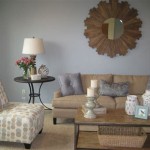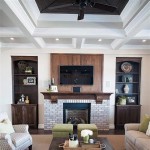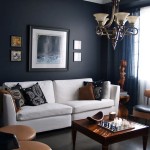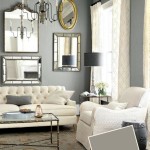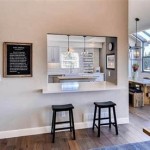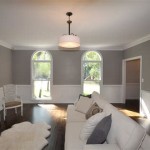Living Room Ideas For Odd Shaped Rooms
Designing a living room within an oddly shaped space presents unique challenges. Standard furniture arrangements and typical design principles may not readily apply. However, these unconventional spaces also offer opportunities for creative and personalized design solutions. The key lies in understanding the room's specific irregularities and adapting design choices to maximize functionality and aesthetic appeal.
Instead of viewing an unusual room shape as a limitation, consider it as a canvas that encourages innovative thinking. This article explores various strategies for effectively designing living rooms with non-traditional layouts, focusing on optimizing space utilization, addressing architectural quirks, and creating a balanced and inviting environment.
Analyzing the Odd Shape: Identifying Challenges and Opportunities
The first step in designing an odd-shaped living room is a thorough analysis of the space. This involves identifying the specific architectural irregularities that define the room's unique shape. Common challenges include acute angles, alcoves, excessively long and narrow dimensions, or rooms with multiple entry points. Each of these features necessitates a tailored design approach.
Acute angles can often feel awkward and unused. Strategies to address this include incorporating custom-built shelving or seating that fits precisely into the angle. Another option is to create a small reading nook with a comfortable chair and appropriate lighting. Alternatively, a large potted plant or sculptural element can soften the harshness of the angle and visually integrate it into the overall design.
Alcoves, on the other hand, present opportunities for creating distinct zones within the living room. An alcove can be transformed into a home office area with a desk and ergonomic chair, a bar area with shelving for glassware and bottles, or a children's play area. Carefully consider the size and location of the alcove in relation to the main living area to determine the most appropriate function.
Long and narrow rooms require careful planning to avoid a tunnel-like effect. Dividing the space into distinct zones using furniture placement, area rugs, or changes in flooring can help break up the length of the room. Position furniture perpendicular to the longest walls to visually widen the space. Mirrors strategically placed on the shorter walls can also create the illusion of greater width.
Rooms with multiple entry points can be difficult to furnish because they limit the amount of available wall space. It is crucial to define clear pathways between these entry points to ensure smooth traffic flow. Avoid obstructing these pathways with furniture. Instead, use furniture to delineate functional areas, such as a seating area or a reading corner. Consider incorporating open shelving or console tables along the paths to define the space without creating a visual barrier.
Optimizing Space and Functionality: Furniture Selection and Placement
The selection and placement of furniture are critical in maximizing space and functionality in an odd-shaped living room. Standard furniture sets may not be the most effective choice. Instead, opt for modular furniture that can be easily arranged and reconfigured to fit the room's specific dimensions.
Sectional sofas are particularly versatile for odd-shaped spaces. They can be customized to fit around corners, wrap around alcoves, or create a U-shaped seating arrangement in a long and narrow room. Choose a sectional with adjustable sections to allow for flexibility in the arrangement. Consider sectionals with built-in storage to further maximize space utilization.
Smaller-scale furniture is generally more appropriate for odd-shaped rooms than large, bulky pieces. Oversized furniture can overwhelm the space and make it feel cramped. Opt for chairs and tables with slender profiles and clean lines. Consider incorporating nesting tables that can be easily stored when not in use.
Floating shelves are an excellent alternative to traditional bookshelves in rooms with limited wall space. They provide ample storage without taking up valuable floor space. Floating shelves can be arranged in various configurations to create visual interest and complement the room's unique shape. They can be used to display books, artwork, or decorative objects.
Multifunctional furniture is particularly valuable in small or odd-shaped living rooms. Consider incorporating a coffee table with built-in storage, an ottoman that doubles as a seating area and storage container, or a sofa bed that can be used for guests. These pieces help maximize the utility of the space without sacrificing comfort or style.
When arranging furniture, start by identifying the focal point of the room. This could be a fireplace, a large window with a view, or a piece of artwork. Arrange the furniture around the focal point to create a cohesive and inviting space. Consider the traffic flow in the room and ensure that there are clear pathways between different zones. Avoid blocking doorways or creating obstacles that could impede movement.
Creating Visual Harmony: Color, Lighting, and Accessories
The use of color, lighting, and accessories can significantly impact the overall aesthetic of an odd-shaped living room. These elements can be used to create visual harmony, balance the proportions of the room, and enhance its overall appeal.
Color plays a crucial role in shaping the perception of space. Lighter colors tend to make a room feel larger and more open, while darker colors can make it feel smaller and more intimate. In an odd-shaped room, it is generally advisable to use lighter colors on the walls to maximize the feeling of spaciousness. Accent walls in darker or bolder colors can be used to highlight specific architectural features or create visual interest.
Strategic use of color can also help to balance the proportions of an odd-shaped room. For example, painting the shorter walls of a long and narrow room in a lighter color than the longer walls can help to visually widen the space. Similarly, painting the ceiling in a lighter color than the walls can make the room feel taller.
Lighting is essential for creating a welcoming and functional living room. In an odd-shaped room, it is particularly important to layer different types of lighting to provide adequate illumination and create visual interest. This includes ambient lighting, task lighting, and accent lighting.
Ambient lighting provides overall illumination for the room. This can be achieved with recessed lighting, ceiling fixtures, or floor lamps. Task lighting is used for specific activities, such as reading or working. This can be provided by table lamps, floor lamps with adjustable arms, or pendant lights. Accent lighting is used to highlight specific features, such as artwork or architectural details. This can be achieved with spotlights, track lighting, or wall sconces.
Accessories can add personality and character to an odd-shaped living room. Choose accessories that complement the room's overall style and color scheme. Consider incorporating artwork, throw pillows, rugs, and decorative objects. Avoid cluttering the space with too many accessories, as this can make it feel cramped and overwhelming.
Mirrors are a particularly effective accessory for odd-shaped rooms. They can be used to reflect light, create the illusion of greater space, and add visual interest. Place mirrors strategically to maximize their impact. Consider hanging a large mirror on a wall that faces a window to reflect natural light into the room. Alternatively, use a grouping of smaller mirrors to create a focal point.
Rugs can be used to define different zones within an odd-shaped living room. Choose rugs that are appropriately sized for the areas they are defining. A large rug can be used to anchor a seating area, while a smaller rug can be used to define a reading nook or a conversation area. Consider using rugs with bold patterns or colors to add visual interest to the room.
By carefully considering these factors, it is possible to transform an odd-shaped living room into a functional, stylish, and inviting space. The key is to embrace the room's unique characteristics and adapt design choices accordingly. The result will be a living room that is both beautiful and practical, perfectly tailored to the needs and preferences of its occupants.

Interior Design For Awkwardly Shaped Spaces Ellecor

Making An Awkward Shaped Living Room Work

How To Decorate An Oddly Shaped Room And Love It Home Garden

How To Arrange Furniture In An Odd Shaped Room

How To Arrange An Odd Shaped Living Room

Oddly Shaped Living Room For Improvement Design Time Youtube

36 Odd Shaped Room Design Ideas Digsdigs

Furniture Placement In Odd Shaped Living Room

How To Arrange An Odd Shaped Living Room

How To Deal With An Awkwardly Shaped Living Room Houzz Ie

